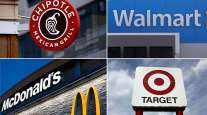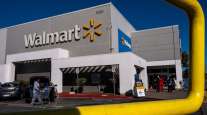Retail Sales Disappoint Again

Sales at U.S. retailers changed little in April, starting the second quarter on a weak note as Americans remained reluctant to splurge.
The reading followed a revised 1.1% gain in March that was the biggest in a year and larger than previously estimated, Commerce Department figures showed May 13 in Washington. The median forecast of 88 economists surveyed by Bloomberg News called for a 0.2% gain in April.
Consumers have been using the windfall from cheap gasoline to boost savings as wages have been slow to pick up, which may temper the projected rebound in U.S. growth this quarter. At the same time, steady hiring and low borrowing costs will help underpin household spending, which accounts for about 70% of the economy.
“It’s certainly a disappointing report,” said Guy Berger, an economist at RBS Securities Inc. in Stamford, Connecticut, who projected sales would be unchanged and is the top-ranked forecaster for retail purchases over the past two years, according to data compiled by Bloomberg News. “We are going to need to see some of these categories that were weak in April firm up in May and June.”
Absent that, “there’ll be some head-scratching that the economy is not coming back as strong as expected,” he said.
Another report April 13 showed the cost of foreign-made goods unexpectedly dropped 0.3% in April as the relatively strong dollar held down expenses for such things as food and automobiles. The decrease in the import-price index compared was a 0.3% gain that was the median forecast of economists surveyed by Bloomberg.
Non-fuel imports were 2.3% cheaper over the past 12 months, the biggest year-to-year decline since October 2009. The costs of foreign vehicles fell 1.9% over that period, the biggest drop since data began in 1981.
Stock-index futures trimmed earlier gains after the disappointing retail sales data. The contract on the Standard & Poor’s 500 Index maturing in June rose 0.1% to 2,097.4 at 8:50 a.m. in New York after having been up as much as 0.5%.
Retail-sales estimates in the Bloomberg survey ranged from a decline of 0.5% to an advance of 1%. The March figure was previously reported as an increase of 0.9%.
Seven of 13 major categories showed gains, led by restaurants and bars and online merchants, the report showed. A tiny advance among miscellaneous stores tipped the balance in favor of gainers.
The dour tone of the report was reinforced by declines among discretionary items such as automobiles, furniture and electronics. Demand at grocery stores, service stations and general merchandise retailers also declined. The latter category includes department stores, which saw their biggest drop in purchases since January 2014, when snow blanketed much of the United States.
Sales declined 0.4% at automobile dealers, after jumping 2.9% the previous month.
Industry data from Ward’s Automotive Group issued earlier this month showed cars and light trucks sold at a 16.5 million annualized rate in April, down from 17 million the prior month.
General Motors Co.’s April sales exceeded projections while gains at Ford Motor Co., Toyota Motor Corp., and Nissan Motor Co. were less than predicted. With gasoline prices down by almost a third from a year ago, demand for large and luxury sport utility vehicles is soaring.
Retail sales excluding autos increased 0.1%, the Commerce Department report showed. They were projected to rise 0.5%, according to the Bloomberg survey median. It followed a 0.7% advance in March that was larger than previously estimated.
The figures used to calculate gross domestic product, which exclude categories such as food services, auto dealers, home-improvement stores and service stations, was little changed after a 0.5% increase in the previous month in the so-called control group that was larger than previously estimated.
The upward revisions to most categories for March were a saving grace for the otherwise disappointing figures for April, and indicate consumer spending in the first quarter will be stronger than previously estimated.
Unusually harsh winter weather was blamed for some of the slowdown in retail sales in the early part of 2015, when delays related to a West Coast port dispute also held back other economic activity. The economy barely grew in the first quarter, with GDP advancing at a 0.2% annualized rate.
Household consumption expanded 1.9% in the January through March period, according to Commerce Department data issued last month.
Economists may mark down estimates for this quarter after the retail sales figures. Consumer spending was projected to accelerate to 3.5% in the April through June period, according to the median forecast of economists surveyed by Bloomberg in April.
Since it’s still early in the quarter, some economists are more sanguine.
“It’s too early to add up the quarter based on one disappointing number,” Jim O’Sullivan chief U.S. economist at High Frequency Economics in Valhalla, New York, said before the report. “The job market is improving. Wage income is growing. Wealth has been generally rising, that’s a plus on top of wage income growth.”
First-quarter results showed the saving rate climbed to 5.5%, the highest since the end of 2012. Disposable income adjusted for inflation rose at a 6.2% annualized rate, the most in more than two years, according to the Commerce Department figures.
The labor market continues to provide the wherewithal for Americans to spend. Payrolls bounced back in April with a 223,000 increase following a 85,000 gain the prior month, and the jobless rate fell to 5.4%, the lowest since May 2008, according to Labor Department data.
Wage gains remain steady at relatively low levels. Hourly pay was up 2.2% in April from a year earlier, holding within the narrow range tracked over the past four years.
Improving home sales and demand for remodeling-related materials bode well for companies such as Sherwin-Williams Co., the largest U.S. paint retailer.
“We remain optimistic that U.S. residential demand for architectural paint will continue to strengthen as we move into the prime painting season,” Chris Connor, CEO, said during an April 16 conference call with analysts. Sherwin-Williams predicted second-quarter sales may rise as much as 8%, and reiterated its full-year earnings forecast.
Gasoline Consumer Spending Washington New York Stamford Connecticut Price Index Imports Cars Sport Utility Vehicles.




